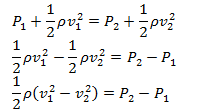Question 3: Consider the cross-section of the wing on an aero plane. The wing is designed such that the air travels faster over the top than under the bottom. Explain why there is a net upward thrust (lift) on the wing due to Bernoulli’s effect?
ANSWER
Wings of aero planes are designed in such a way that air travels faster at the top of the wing as compared to its bottom. This results a difference in the pressure above and below the surfaces of the wings. The pressure above the wing is less than the pressure below the wing. The difference in pressure below and above the wing causes an upward thrust.
Bernoulli’s principle is;
![]()
Now suppose,
v1 is the speed of air above the wing
P1 is the pressure of air above the wing
h1 is the height of the upper surface of the wing.
And
v2 is the speed of air below the wing
P2 is the pressure of air below the wing
h2 is the height of the lower surface of the wing.
Applying Bernoulli’s principle![]()
h1 and h2 may be considered the same and, therefore, h1 = h2 = h
Substituting in the above equation,![]()

Now, v1 = speed of air above the wing.
v2 = speed of air below the wing.
Since by design, v1 > v2, therefore, ![]() is a positive integral quantity. Hence, P2 – P1 is also positive. Let
is a positive integral quantity. Hence, P2 – P1 is also positive. Let
LHS of the equation is the force on the plane acting upward which is the net thrust on the wing according to Bernoulli’s effect.

Pingback:index-sq6-p11